人教版高中英语必修一unit1经典教案
- 格式:doc
- 大小:91.00 KB
- 文档页数:10
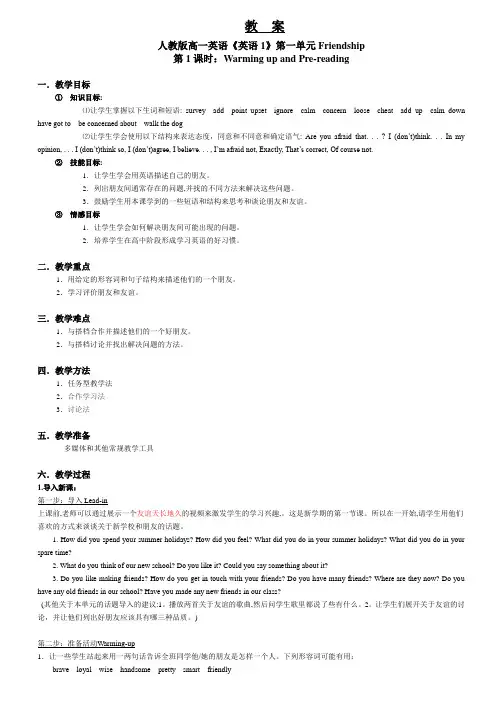
教案人教版高一英语《英语1》第一单元Friendship第1课时:Warming up and Pre-reading一.教学目标①知识目标:⑴让学生掌握以下生词和短语: survey add point upset ignore calm concern loose cheat add up calm down have got to be concerned about walk the dog⑵让学生学会使用以下结构来表达态度,同意和不同意和确定语气: Are you afraid that. . . ? I (don’t)think. . . In my opinion, . . . I (don’t)think so, I (don’t)agree, I believe. . . , I’m afraid not, Exactly, That’s correct, Of course not.②技能目标:1.让学生学会用英语描述自己的朋友。
2.列出朋友间通常存在的问题,并找的不同方法来解决这些问题。
3.鼓励学生用本课学到的一些短语和结构来思考和谈论朋友和友谊。
③情感目标1.让学生学会如何解决朋友间可能出现的问题。
2.培养学生在高中阶段形成学习英语的好习惯。
二.教学重点1.用给定的形容词和句子结构来描述他们的一个朋友。
2.学习评价朋友和友谊。
三.教学难点1.与搭档合作并描述他们的一个好朋友。
2.与搭档讨论并找出解决问题的方法。
四.教学方法1.任务型教学法2.合作学习法3.讨论法五.教学准备多媒体和其他常规教学工具六.教学过程1.导入新课:第一步:导入Lead-in上课前,老师可以通过展示一个友谊天长地久的视频来激发学生的学习兴趣,。
这是新学期的第一节课。
所以在一开始,请学生用他们喜欢的方式来谈谈关于新学校和朋友的话题。
1. How did you spend your summer holidays? How did you feel? What did you do in your summer holidays? What did you do in your spare time?2. What do you think of our new school? Do you like it? Could you say something about it?3. Do you like making friends? How do you get in touch with your friends? Do you have many friends? Where are they now? Do you have any old friends in our school? Have you made any new friends in our class?(其他关于本单元的话题导入的建议:1。
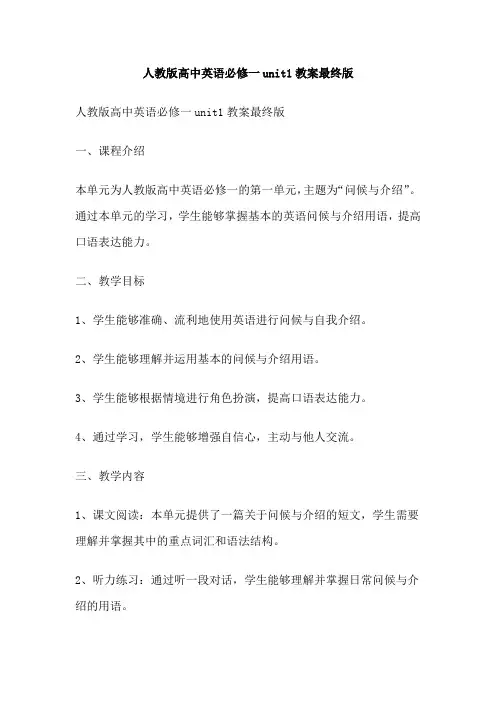
人教版高中英语必修一unit1教案最终版人教版高中英语必修一unit1教案最终版一、课程介绍本单元为人教版高中英语必修一的第一单元,主题为“问候与介绍”。
通过本单元的学习,学生能够掌握基本的英语问候与介绍用语,提高口语表达能力。
二、教学目标1、学生能够准确、流利地使用英语进行问候与自我介绍。
2、学生能够理解并运用基本的问候与介绍用语。
3、学生能够根据情境进行角色扮演,提高口语表达能力。
4、通过学习,学生能够增强自信心,主动与他人交流。
三、教学内容1、课文阅读:本单元提供了一篇关于问候与介绍的短文,学生需要理解并掌握其中的重点词汇和语法结构。
2、听力练习:通过听一段对话,学生能够理解并掌握日常问候与介绍的用语。
3、口语表达:学生需要进行多次口语练习,包括个人介绍、两人对话、小组讨论等,提高口语表达能力。
4、写作训练:学生需要写一篇关于自己或他人的介绍文章,巩固所学知识。
四、教学步骤1、导入新课:通过简单的问候,引导学生进入本单元的主题。
2、讲解新词:学习本单元的新单词,包括生词、词组和习惯用法。
3、课文阅读:阅读本单元提供的短文,并回答相关问题。
4、听力练习:听一段对话,并回答相关问题。
5、口语表达:进行多次口语练习,包括个人介绍、两人对话、小组讨论等。
6、写作训练:写一篇关于自己或他人的介绍文章。
7、复习巩固:回顾本单元所学内容,加深印象。
五、教学评价1、课堂提问:通过提问,检测学生对本单元重点内容的掌握情况。
2、小测验:进行小测验,检测学生对本单元重点词汇、语法和习惯用法的掌握情况。
3、课后作业:布置课后作业,让学生巩固本单元所学内容。
六、教学反思1、成功之处:通过多种教学方法的运用,本节课取得了良好的教学效果,学生积极参与,课堂氛围热烈。
2、不足之处:部分学生的口语表达能力还有待提高,需要加强针对性的训练。
3、改进措施:针对学生的不足,制定个性化的教学方案,加强针对性的训练,提高学生的口语表达能力。
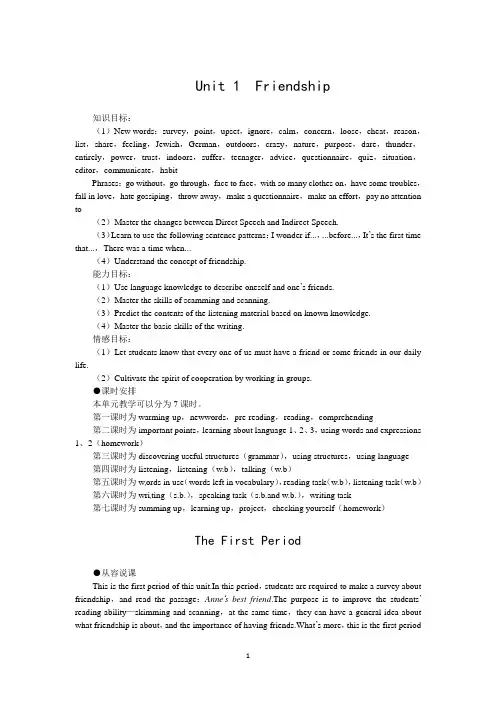
Unit 1 Friendship知识目标:(1)New words:survey,point,upset,ignore,calm,concern,loose,cheat,reason,list,share,feeling,Jewish,German,outdoors,crazy,nature,purpose,dare,thunder,entirely,power,trust,indoors,suffer,teenager,advice,questionnaire,quiz,situation,editor,communicate,habitPhrases:go without,go through,face to face,with so many clothes on,have some troubles,fall in love,hate gossiping,throw away,make a questionnaire,make an effort,pay no attention to(2)Master the changes between Direct Speech and Indirect Speech.(3)Learn to use the following sentence patterns:I wonder if...,...before...,It’s the first time that...,There was a time when...(4)Understand the concept of friendship.能力目标:(1)Use language knowledge to describe oneself and one’s friends.(2)Master the skills of scamming and scanning.(3)Predict the contents of the listening material based on known knowledge.(4)Master the basic skills of the writing.情感目标:(1)Let students know that every one of us must have a friend or some friends in our daily life.(2)Cultivate the spirit of cooperation by working in groups.●课时安排本单元教学可以分为7课时。
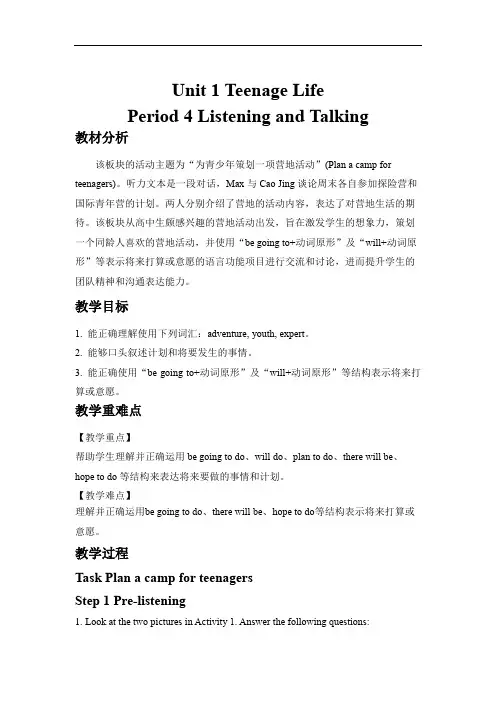
Unit 1 Teenage LifePeriod 4 Listening and Talking教材分析该板块的活动主题为“为青少年策划一项营地活动”(Plan a camp for teenagers)。
听力文本是一段对话,Max与Cao Jing谈论周末各自参加探险营和国际青年营的计划。
两人分别介绍了营地的活动内容,表达了对营地生活的期待。
该板块从高中生颇感兴趣的营地活动出发,旨在激发学生的想象力,策划一个同龄人喜欢的营地活动,并使用“be going to+动词原形”及“will+动词原形”等表示将来打算或意愿的语言功能项目进行交流和讨论,进而提升学生的团队精神和沟通表达能力。
教学目标1. 能正确理解使用下列词汇:adventure, youth, expert。
2. 能够口头叙述计划和将要发生的事情。
3. 能正确使用“be going to+动词原形”及“will+动词原形”等结构表示将来打算或意愿。
教学重难点【教学重点】帮助学生理解并正确运用be going to do、will do、plan to do、there will be、hope to do等结构来表达将来要做的事情和计划。
【教学难点】理解并正确运用be going to do、there will be、hope to do等结构表示将来打算或意愿。
教学过程Task Plan a camp for teenagersStep 1 Pre-listening1.Look at the two pictures in Activity 1. Answer the following questions:(1)What kind of camp is Adventure Camp/International Youth Camp?(2)What activities will it include?(3)What can students learn in these activities?2.Read the sentences in Activity 1. Then predict the main idea of the conversation. Step 2 While-listening1. Work on Activity 1. Listen to the conversation and tick what are heard about the camps.2.Work on Activity 2. Underline the expressions in the sentences above that Cao Jing and Max use to talk about the future.设计意图:该环节让学生通过勾画听力文本中的目标结构,关注对话中如何表达将来要做的事情和计划。
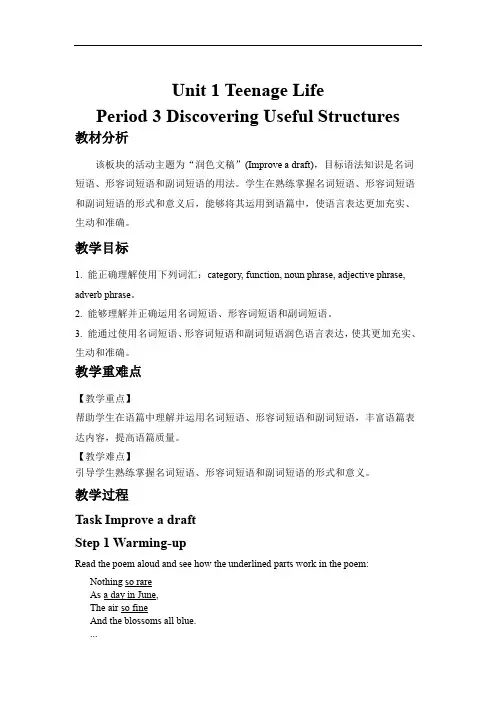
Unit 1 Teenage LifePeriod 3 Discovering Useful Structures 教材分析该板块的活动主题为“润色文稿”(Improve a draft),目标语法知识是名词短语、形容词短语和副词短语的用法。
学生在熟练掌握名词短语、形容词短语和副词短语的形式和意义后,能够将其运用到语篇中,使语言表达更加充实、生动和准确。
教学目标1. 能正确理解使用下列词汇:category, function, noun phrase, adjective phrase, adverb phrase。
2. 能够理解并正确运用名词短语、形容词短语和副词短语。
3. 能通过使用名词短语、形容词短语和副词短语润色语言表达,使其更加充实、生动和准确。
教学重难点【教学重点】帮助学生在语篇中理解并运用名词短语、形容词短语和副词短语,丰富语篇表达内容,提高语篇质量。
【教学难点】引导学生熟练掌握名词短语、形容词短语和副词短语的形式和意义。
教学过程Task Improve a draftStep 1 Warming-upRead the poem aloud and see how the underlined parts work in the poem: Nothing so rareAs a day in June,The air so fineAnd the blossoms all blue....Its beautiful melodyFloats like a balloon.Step 2 Observing1. Work on Activity 1. Students find and mark the noun/ adjective/ adverb phrases in the following sentences:(1) The first week was a little confusing.(2) The building is so big that I’m completely lost.(3) The kids over there are putting something on a round paper plate....2.Students observe the sentences again and state the phrases’ functions.设计意图:该环节让学生通过观察例句,发现句子中的目标短语结构,进一步感知其在语言表达中所起到的作用。
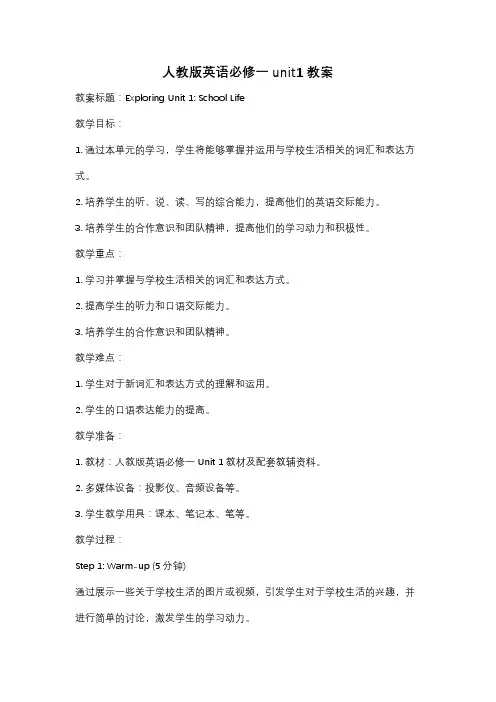
人教版英语必修一unit1教案教案标题:Exploring Unit 1: School Life教学目标:1. 通过本单元的学习,学生将能够掌握并运用与学校生活相关的词汇和表达方式。
2. 培养学生的听、说、读、写的综合能力,提高他们的英语交际能力。
3. 培养学生的合作意识和团队精神,提高他们的学习动力和积极性。
教学重点:1. 学习并掌握与学校生活相关的词汇和表达方式。
2. 提高学生的听力和口语交际能力。
3. 培养学生的合作意识和团队精神。
教学难点:1. 学生对于新词汇和表达方式的理解和运用。
2. 学生的口语表达能力的提高。
教学准备:1. 教材:人教版英语必修一Unit 1教材及配套教辅资料。
2. 多媒体设备:投影仪、音频设备等。
3. 学生教学用具:课本、笔记本、笔等。
教学过程:Step 1: Warm-up (5分钟)通过展示一些关于学校生活的图片或视频,引发学生对于学校生活的兴趣,并进行简单的讨论,激发学生的学习动力。
Step 2: Pre-reading (10分钟)教师通过提问的方式,引导学生预测本单元课文的内容,并激发学生对于学校生活的思考。
Step 3: While-reading (30分钟)3.1 学生个人阅读课文,并回答与课文内容相关的问题,以检测学生对于课文的理解程度。
3.2 学生分组合作,进行小组讨论,分享对于学校生活的看法和体验,并准备一份小组报告,展示给全班同学。
Step 4: Post-reading (15分钟)教师组织学生进行角色扮演活动,让学生在模拟的学校生活情境中运用所学的词汇和表达方式进行交流。
Step 5: Consolidation (10分钟)教师设计一系列练习题,巩固学生对于本单元所学知识的掌握程度,并进行课堂点评和讲解。
Step 6: Homework (5分钟)布置适当的家庭作业,要求学生复习本单元所学内容,并准备下节课的学习。
教学评估:1. 在课堂上观察学生的参与度和合作情况,评估学生的学习态度和团队精神。
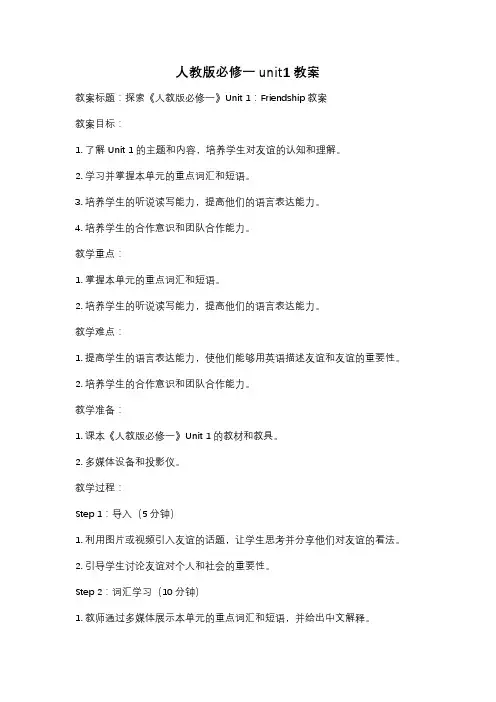
人教版必修一unit1教案教案标题:探索《人教版必修一》Unit 1:Friendship教案教案目标:1. 了解Unit 1的主题和内容,培养学生对友谊的认知和理解。
2. 学习并掌握本单元的重点词汇和短语。
3. 培养学生的听说读写能力,提高他们的语言表达能力。
4. 培养学生的合作意识和团队合作能力。
教学重点:1. 掌握本单元的重点词汇和短语。
2. 培养学生的听说读写能力,提高他们的语言表达能力。
教学难点:1. 提高学生的语言表达能力,使他们能够用英语描述友谊和友谊的重要性。
2. 培养学生的合作意识和团队合作能力。
教学准备:1. 课本《人教版必修一》Unit 1的教材和教具。
2. 多媒体设备和投影仪。
教学过程:Step 1:导入(5分钟)1. 利用图片或视频引入友谊的话题,让学生思考并分享他们对友谊的看法。
2. 引导学生讨论友谊对个人和社会的重要性。
Step 2:词汇学习(10分钟)1. 教师通过多媒体展示本单元的重点词汇和短语,并给出中文解释。
2. 学生跟读并模仿发音,利用图片和例句帮助学生理解词汇的意思和用法。
Step 3:听力训练(15分钟)1. 教师播放录音材料,要求学生听并完成相关的听力练习。
2. 学生互相检查答案,并与教师一起核对答案。
Step 4:口语练习(20分钟)1. 学生分成小组,每个小组选择一个友谊的话题进行讨论,并记录下他们的观点和想法。
2. 每个小组派一名代表向全班汇报他们的讨论结果,并与其他小组进行交流和讨论。
3. 教师对学生的表现进行点评和指导,帮助他们提高语言表达能力。
Step 5:阅读训练(15分钟)1. 学生阅读本单元的阅读材料,并回答相关的问题。
2. 学生互相检查答案,并与教师一起核对答案。
Step 6:写作练习(20分钟)1. 学生根据本单元的写作任务,撰写一篇关于友谊的短文。
2. 学生互相交换作文,并提出修改意见和建议。
3. 学生修改并完善自己的作文,并将其展示给全班。
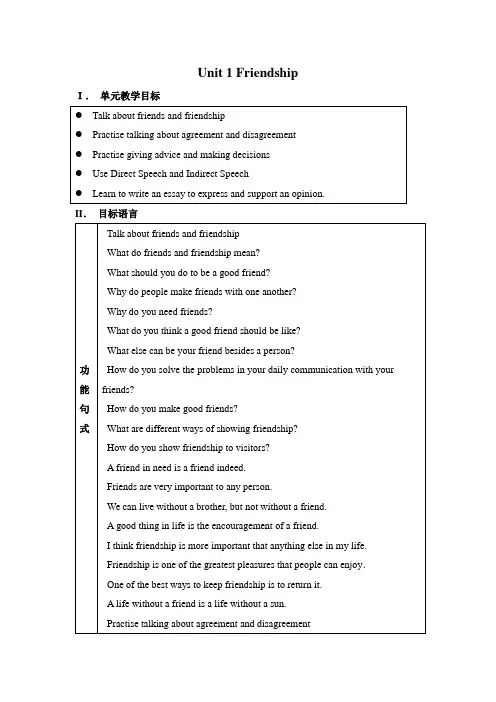
Unit 1 Friendship I.单元教学目标II.目标语言III. 教材分析和教材重组1. 教材分析本单元以Friend和Friendship为话题,旨在通过单元教学使学生通过讨论什么是好朋友,什么是真正的友谊,如何交友和保持友谊等问题,使学生树立正确的交友观。
并针对日常交友过程中经常遇到的实际问题,指导学生发表自己的见解和看法,通过进一步讨论提供有效的解决方案。
并能就此以编辑的身份写出指导信,对相关谚语写出观点明确、论证有力的短文。
1.1 Warming Up以调查问卷的形式,通过对学生在日常交友过程中所遇到的五个问题,展开调查,使学生对是否擅长交友做出评价,激发学生对本单元的中心话题产生兴趣;同时也使教师本单元的授课更具有针对性,从而有效地帮助学生树立正确的交友观。
1.2 Pre-Reading通过四个问题引导学生讨论交友的重要性以及自己心目中好朋友的概念和标准,并使学生认识到不仅人与人,人与物(如日记)也可以成为好朋友。
继续探究并树立正确交友观,并为阅读作好了准备。
1.3 Reading讲述第二次世界大战的纳粹统治时期,犹太人Anne一家过着滇沛流漓,与世隔绝的生活。
Anne在孤独中只能以日记Kitty 为友,倾诉衷肠,伴其渡过两年的逃亡生涯。
控诉了纳粹党的残暴统治给犹太人民带来了深重的灾难,并以日记的形式表达了以主人公Anne为代表的全世界人民憎恨战争渴望和平的共同心愿。
学生学习了新的词汇、句型,提高了阅读水平。
文中选用了主人公的一篇日记,使学生进一步感受到了挚友的可贵,对主人公内心世界的描写有了更深刻的理解。
1.4 Comprehension 设计了三种题型。
其中前两个是考查学生对READING文章细节内容的理解,最后一题是开放性问题,学生可以在更深入理解主人公内心世界的基础上各抒己见,使学生养成勤于思考勇于探究的良好的学习习惯,现时也培养了学生的想象力,进一步提高了阅读水平。
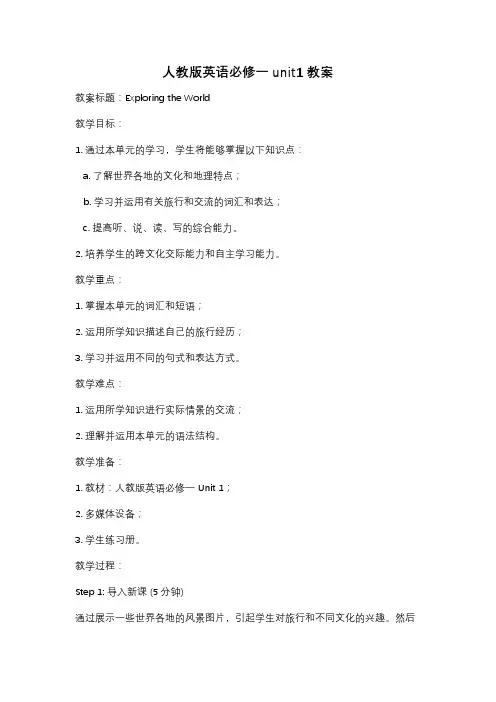
人教版英语必修一unit1教案教案标题:Exploring the World教学目标:1. 通过本单元的学习,学生将能够掌握以下知识点:a. 了解世界各地的文化和地理特点;b. 学习并运用有关旅行和交流的词汇和表达;c. 提高听、说、读、写的综合能力。
2. 培养学生的跨文化交际能力和自主学习能力。
教学重点:1. 掌握本单元的词汇和短语;2. 运用所学知识描述自己的旅行经历;3. 学习并运用不同的句式和表达方式。
教学难点:1. 运用所学知识进行实际情景的交流;2. 理解并运用本单元的语法结构。
教学准备:1. 教材:人教版英语必修一 Unit 1;2. 多媒体设备;3. 学生练习册。
教学过程:Step 1: 导入新课 (5分钟)通过展示一些世界各地的风景图片,引起学生对旅行和不同文化的兴趣。
然后引导学生讨论以下问题:- 你曾经去过哪些地方旅行?- 你对哪个国家或地区最感兴趣?为什么?Step 2: 预习任务 (10分钟)让学生阅读课本 Unit 1 的标题和图片,预测本单元的主题和内容。
然后让学生快速浏览课文,找出文章的主要信息。
Step 3: 听力训练 (15分钟)播放录音材料,让学生完成听力任务,例如填写表格、选择正确答案等。
然后进行听力答案的核对和讨论。
Step 4: 词汇和语法学习 (20分钟)通过多媒体展示本单元的重点词汇和短语,并进行发音和意义的讲解。
然后引导学生进行词汇练习,例如单词拼写、词义选择等。
接着,教授本单元的语法结构,例如现在完成时的用法和构成。
通过多媒体展示相关的例句和练习,让学生理解并运用所学知识。
Step 5: 交流活动 (20分钟)组织学生进行小组活动,让他们以旅行经历为话题,互相交流和分享。
鼓励学生运用所学的词汇和语法结构进行交流,并给予适当的指导和反馈。
Step 6: 课堂练习和作业布置 (10分钟)发放学生练习册,并让学生完成相关练习,巩固所学知识。
同时布置家庭作业,例如写一篇关于自己旅行经历的短文。
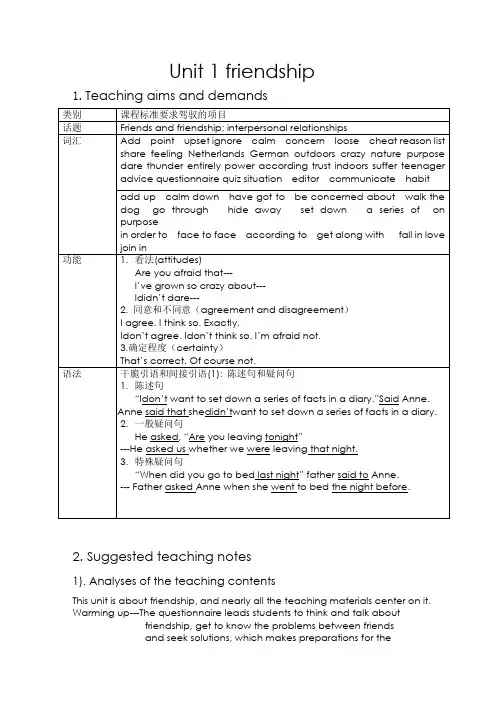
Unit 1 friendship1.Teaching aims and demands2.Suggested teaching notes1). Analyses of the teaching contentsThis unit is about friendship, and nearly all the teaching materials center on it. Warming up---The questionnaire leads students to think and talk aboutfriendship, get to know the problems between friendsand seek solutions, which makes preparations for thefurther teaching in topics, background and vocabulary.Pre-reading---The questions prompt students to think critically aboutfriends and friendship in reality, alerting them to the factthat besides people, a diary can be a friend, too.Reading--- The diary by theJewish girl Anne gave a glimpse of her lifeduring her family’s shelter in Amsterdam from the German Nazis’killing in world war . she treats the diary as her best friend, and in it reveals her longing for a normal life and close contact with nature,which helps her get through the days.Comprehending---It helps students further understand the text by doingmultiple choices, questions and answers, andmatching.Learning about language---It teaches the important expressions andstructures and grammar: direct and indirectspeeches.Using language---The two letters, listening, questionnaire design, letterwriting and fun writing prepares students to furthertalk about friendship, especially the problems withmisunderstanding, and unfriendliness, thusstrengthening students’ abilities to practicelanguage, discover, and solve problems.Summing up---It summarizes the whole contents of this unit from theaspects of topics, vocabulary and grammar.Learning tip--- This part encourages students to form the habit of writinga diary.Integrating skills--- The text introduces the way Hawaiians expressfriendship, to get students to realize the culturaldifferences in the values of friendship in additionits importance in all cultures.2) Making of the teaching planThis unit centers on friends and friendship, exploring different types of friendship with particular attention to that one can develop with oneself,i.e., the comfort and support one seeks from an imaginary friend.Students are expected to come to be truly aware of the qualities and conducts that make a good friend, display and develop the ability tocope with misunderstanding, conflicts and problems related to friendship, and give advice on it. The concept that even an ordinarything can be a friend should break down the traditional belief in the interpersonal nature of friendship. Also, the comparison of similarities dissimilarities in friendship comprehension between the East and theWest leads students to know better the values of friendship in Westerns’eyes. All in all, this unit promises to unveil the true essence of friendshipand helps students to lead a more friendly and harmonious life.Thus, based on the theme, contents and teaching objectives, the whole teaching procedures can fall into five periods as follows:3. Teaching plans for each periodPeriod 1 Warming-up and Speaking1. Teaching objectives:1) Target languageI (don’t) think…… I (don’t) think so. I (don’t) agree.I believe…… That’s correct. In my opinion, ……2) Ability goalsa.Describe your friends in Englishb.Figure out the problems between friends and then find different ways tosolve the problems.3)Learning ability goalsa.To encourage students to think and talk about friends and friendship byusing some phrases and structures.b.To learn to solve problems that may occur between friends.c. To cultivate the students to form the good habit of learning English inSenior Middle School.2. Teaching important points:e the given adjectives and sentence structures to describe one ofyour friends.b.Learn to evaluate friends and friendship.3. Teaching difficult points:a.Work together with partners and describe one of your good friends.b.Discuss with partners and find out ways to solve the problems.4. Teaching methodsa.Task-based teaching and learningb.Cooperative learningc.Discussion5. Teaching aids:CAI6. Teaching procedures and ways:Step 1 Lead-in and Warming-upBefore the lesson, the teacher can arouse the students’ interests by showing a video of Auld Lang Syne .At the beginning of the first class, we can get the students to talk about their summer holidays. The students can talk freely as they like.1.How did you spend your summer holidays How did you feelWhat did you do in your summer holidays What did you do inyour spare time2.What do you think of our new school Do you like it Could yousay something about it3.Do you like making friends How do get in touch with your friendsDo you have many friends Where are they now Do you haveany old friends in our school Have you made any new friends inour classStep 2 Think it over1. Give a brief description of one of your friends. The following phrasesand structures may be helpful:His/Her name is ……He /She is …… years old.He /She likes …… and dislikes ……He /She enjoys …… and hates……He /She is very kind/friendly/……When /Where we got to know each other.2. What types of friendship do you have Please tick them out. Then fillin the blanks.girl friends boy friendspen friendslong -distance friendsfriends of the same agee-friends (friends over the internet) friends across generationsunusual friends like animals, books……1).______ is /are most important to you.2). You spend most of your free time with ____.3). You will share your secrets with _____.4). When in trouble, you will first turn to _____.Step 3 Make a survey1. List some qualities of a good friend or your ideal friend. Have the students get into groups of four to find out what each has listed.Tell your partner your standards of good friends by using the following structure:I think a good friend should (not) be……In my opinion, a good friend is someone who……1.Have a member of each group report on what their lists have in commonand list them on the board.2.Ask the class whether or not they agree with all the qualities listed.3.Then have the students do the survey in the textbook.4.Have the students score their survey according to the scoring sheet onpage 8.5.The teacher ask some students how many points they got for the surveyand assess their values of friendship:★4~7 points: You are not a good friend. You either neglect your friend’s needs or just do what he/she wants you to do. You should think more about what a good friend needs to do.★ 8~12 points: You are a good friend but you sometimes let your friendship become too important, or you fail to show enough concern for your friend’s needs and feelings. Try to strike a balance between your friend’s needs and your own responsibilities.★13+ points: You are an excellent friend who recognizes that to be a good friend you need balance your needs and your friend’s. Well done. (You may also show your students the results above and let themselves self-reflect upon their own values of friendship)Step 4 Talking and sharing( work in pairs)1. If your best friend does something wrong, what will you doTry to use the following phrases:I (don’t) think…… I (don’t) think so.I (don’t) agree. I believe……That’s correct. In my opinion, ……2. What is a friendA British newspaper once offered a prize for the best definition(定义) of a friend. If you were the editior, choose the best one from the following entries(条目), and explain why.One who understands my silence.A friend in need is a friend indeed.Friends are just the people who share your happiness and sorrow.When you look at your watch at 4 am, but still know you can callthem and wake them up, and they’ll still want to talk to you ,that’s friendship.To have a friend, you need to be a good friend.Step 5 Group work (output)The teacher can give each group one of these questions below to talk about. Then let the class share their ideas. It’s better to stimulate the students to express their own opinions about these questions.1.Do you think it is a good idea to borrow money from your friendWhy and Why not2. What factors may cause the breakdown of a good friendship3.What can be your special friend besides human beings And whyStep 6 homework1.Write down a short passage about your ideas /the factors/yourunusual friends.2.Prepare for the new lesson.Period 2 Reading “Anne’s Best F riend”1. Teaching objectives:1) To develop the students’ reading ability, learn to use some reading strategies such as guessing, key sentences, skimming and so on;2). To get the students to realize the importance of friends and friendship,and to tell true friends from false friends;3). To grasp some useful words and expressions in this passage, such as on purpose, be crazy about etc.;4).To learn the writing style of this passage.2. Teaching method: Task-based teaching3). Teaching procedure:Step 1.Pre-reading1. Please enjoy three pieces of music and find out what they are about.2 .Why do you think friends are important to you3. What do you think a good friend should be like List the good qualities a good friend should have .4. Have you ever considered making friends with animals, plants or even an object Why or why notStep 2.Reading1.Try to guess what Anne’s friend is and what the passage is about by reading the title and having a quick at the pictures in this passage without reading it.2.Skimming the first two paragraphs to confirm your guessing.1) What was Anne’s best friend Why did she make friends with it2) Did she have any other true friends then Why3) What is the difference between Anne’s diary and those of most people4) Do you keep a diary What do you think most people set down in their diaries5) We are going to read one of Anne’s diaries .but before readi ng ,can you tell me what the diary is about with the help of one key sentence in the 2nd paragraph3.Reading of Anne’s diaryHow she felt in the hiding placeTwo examples to show her feelings thenStep 3.Post-reading1.What would you miss most if you went into hiding like Anne and her family Give your reasons.2.Group workWork in groups to decide what you would do if your family were going to be killed just because they did something the Emperor did not like.Where would you plan to hideHow would you arrange to get food given to you every dayWhat would you do to pass the time------3. Discovering useful words and expressionsComplete the following sentences,using words and expressions from Reading1) She has grown _______ about computer games.2) Was it an accident or did David do it on _______3) From the beginning ,Paul made it clear that he would be ______ (完全地)in control.4) He used to work _______ even in the middle of winter.5) Just the _______ of more food made her feel sick.6) You had better have a _________ talk with him.7) Born in a poor family, the manager _________ lots of hardships in his childhood.8) A diary is often kept to ________ what happens in people’s daily lives.Step 4.Talking about friends and friendship1.There are many proverbs about friends and friendship. Choose the one you agree with and explain why, then choose one you disagree with and explain why.A friend in need is a friend indeed.Friends are like wine; the older,the better.A friend to all is a friend to none.The same man cannot be both friend and flatterer(阿谀奉承者).False friends are worse than open enemies.Walking with a friend in the dark is better than walking alone in the light.2.We have talked about friends and friendship today, can you write one or two sentences to express your understanding of friends and friendship.Step 5.Homework:1.Interview a high school student, a businessman, a police officer and a housewife to find out their opinions about friends and friendship. Write a report to share it with the whole class.2. Describe one of your best friends following the writing style of this passage. Ending: Let’s sing this song about friends togetherPeriod3 GrammarDirect & Indirect SpeechI Statements & Questions1.Teaching objectivesLearn to use direct speech and indirect speech2. Teaching important pointSummarize the rules of Direct Speech and Indirect Speech.3. Teaching difficult pointLearn about the special cases in which the tenses shouldn’t be changed.4.Teaching methodsDiscussing, summarizing and practicing.5. Teaching proceduresStep1Lead inT:Good morning, class. In the last lesson, we learned Anne’s story. Now she is telling her stories to two of her friends—you and Tom. Tom has something wrong with his ears,so you have t o repeat Anne’s sentences, Sometimes you need to explain Tom’s sentences to the class. Look at the blackboard.“I have to stay in the hiding place.” said Anne.→T:What did Anne say As we know , Tom has something wrong with his ears,so you have to repeat Anne’s sentence.Ok,first of all, let’s translate the sentence into Chinese.安妮说:“我不得不呆在躲藏处。
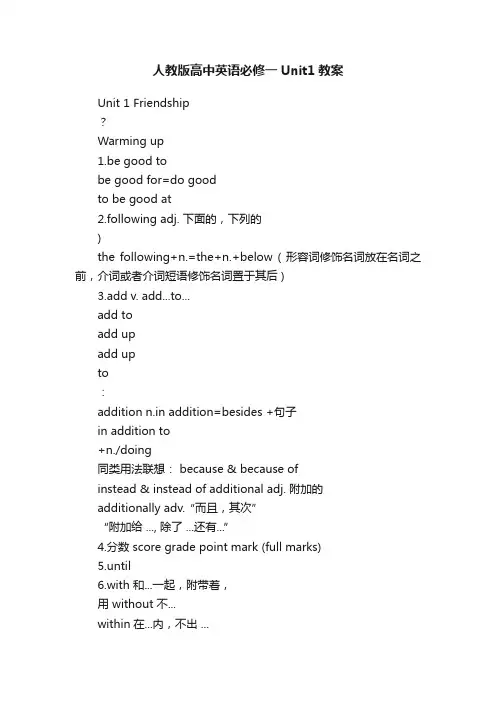
人教版高中英语必修一Unit1教案Unit 1 FriendshipWarming up1.be good tobe good for=do goodto be good at2.following adj. 下面的,下列的)the following+n.=the+n.+below ( 形容词修饰名词放在名词之前,介词或者介词短语修饰名词置于其后 )3.add v. add...to...add toadd upadd upto:addition n.in addition=besides +句子in addition to+n./doing同类用法联想: because & because ofinstead & instead of additional adj. 附加的additionally adv.“而且,其次”“附加给 ..., 除了 ...还有...”4.分数 score grade point mark (full marks)5.until6.with 和...一起,附带着,用 without 不...within在...内,不出 .... write with a peneat with hands/ spoon/chopsticks/knife and fork He left without saying goodbye.He left with the water running.分析:saying 前无名词,则是主语发出saying 的动作;running 前有 water,因此是 water 发出 running 的动作,而不是句子的主语 he。
翻译练习:(1)他今天去上班没带领带。
Today, he went to work without (wearing) his tie.(2)他在没有其他人帮助的情况下自己完成了作业。
7.pay forpay to dosth8. get sb to do sth(make/have/let sb do sth)get sb/sth doneget done get lost/prepared/dressed/involved9.形容词做状语,表示句子主语的特征、属性和状态副词做状语,表示谓语动词的完成方式. He returned home last night, sad and disappointed.He left hurriedly.10. concern n. 担心,忧虑concern about/for/over.... She hasn’tbeen seen for four days and there is concern for her safety.That is a big concern.v. 涉及,与 ...有关be concerned withconcerning . He asked several questions concerning the future of thecompany. 翻译练习:不要问女人们涉及她们年龄的问题。
【英语】新人教版必修一 Unit1 示范教案Teaching planUnit oneTeaching aims:1. 能力目标:①Listening: gain useful information and clear views from the listening material;②Speaking: express one’s attitude or views about friends and friendship in appropriate words.③Reading: let Ss summarize the main idea④Writing: write a letter about how to make friends2. 知识目标:①Talk about friends and friendship; how to BE friends; how to gain friendship②Use the following expression:so do I / neither do II think it is a good ideaAll rightYes,but…③to get the Ss to master direct speech and indirect speech④vocabulary and phrases: upset, calm, concern, careless, loose, cheat, list, share, German, series, outdoors, crazy, purpose, thunder, entirely, power, trust, suffer, teenager, advice, quiz, editor, communicate, situation, add up, calm down, have got to, be concerned about, walk the dog, go through, hide away, set down, a series of, on purpose, so as to, face to face, according to, get along with, fall in love with, join in, be upset about, for once3. 情感目标:①To ari se Ss’ interest in learning English;②To encourage Ss to take part in the activities and make Ss confident;③To develop the ability to cooperate and communicate with others.4. 策略目标:①To develop Ss’ cognitive strategy: making notes when listening carefully;②To develop and improve Ss’ communicative strategies.5. 文化目标:To enable the Ss to come to know different opinions about making friends from different countries.6. 现实目标①To make Ss respect each other and friendship②To make them get well with one another in societyTeaching steps:Period oneStep 1. warming up1. Ss listen to an English song AULD LANG SYNE.2. Brainstorming: let Ss say some words about friendship:careful, warm-hearted, honest, friendly, brave, humorous, funny, smart, kind, open-minded, responsible….3. To let Ss make a correct choice about their questions that they meet in warming up.Step 2. practice speaking1. Ss talk about their old friends in Junior Middle School, talk about theirappearance, personality, hobbies, etc.2. Self-introduction or work in pairs3. Ss can ask some questions about life or learningStep 3. Make new friends1. Ss go around and ask their new friends some information and fill in the following form name age/hobbies/favorite sport s, books …2. Report to the class: who will probably be your friend why.Step 4. Do a surveySs do the survey in the text on P1Step 5. Listening and talkingDo Workbook on P41 (Talking). While Ss listen to the material, ask them to take notes about t he speaker’s views of making friends.When Ss make their conversation, ask them to try to use the following expressions.I am afraid not exactly I agree I think that is a good idea of course notStep 6. DiscussionDivide Ss four in one group and each group choose a topic to discuss. There are four topics.Topic 1: Why do you need friends? Make a list of reasons why friends are important to you.Topic 2: There is a saying “to have a good friend, you need to be a good friend.” What do you think of the saying and how can you be a good friend?Topic 3: Does a friend always have to be a person? What else can be your friend? Why?Topic 4: List some qualities of a person who does not make friend easily.Step 7. Summary1. Ask Ss themselves to summarize what is friendship and what is the most important in making friends.2. T shows more information about friendship and a poem about friendship.What is friendship?I want to find the answer to the questionWhat is friendship?When it rains, I think friendship is a small umbrella.It can give me a piece of clear sky.When I’m crying, I think friendship is a white handkerchief.It can wipe my tears dry.When I am sad, I think friendship is a warm word.It can bring me happiness again.When I am in trouble, I think friendship is a strong hand.It can help me escape my troubles.When I sit in a quiet place, I think friendship is a very wonderful feeling.It can’t be pulled and torn, because it is in everyone’s heart.It is there from the beginning to the end of our lives.3. Tell Ss: make new friends and keep the old; one is silver and the other is gold.Step 8. EvaluationSs finish the following evaluation form. Standard: A, B, CContents 自评他评1. I’m active in talking with others.2. I’m active in cooperating with others.3. I can express myself fluently, accurately and appropriately.4. I know more about friendship after the lesson…5. Do you think you need to improve yourself in some ways? Which ways?Homework:1. Look up the new words and expressions in warm-up and pre-reading in a dictionary.2. Write a short passage about your best friend.Period twoStep 1. Warming upActivity 1: Suppose you have to stay indoors to hide yourself for a whole year. You can never go outdoors, otherwise you will be killed. You have no telephone, computer, or TV at home.How would you feel?What would you do?Four students a group discuss with each other for 2 minutes.Activity 2: Play a short part of the moviesStep 2. PredictingStudents read the title of the passage and observe the pictures and the outline of it to guess:Who is Anne’s best friend?What will happen in the passage?Step 3. SkimmingStudents skim the passage in 2 minutes to get the main idea:Who is Anne’s best friend?When did the story happen?Step 4. ScanningStudents work in pairs to find the information required below:Anne in World War ⅡStep 5. Intensive readingStudents work in groups of four to discuss the following open questions:1. Why did the windows stay closed?2. How did Anne feel?3. What do you think of Anne?4. Guess the meanings of “spellbound”, “hold me entirely in their power”from the discourse(语篇,上下文).5. Which sentences attract you in the passage?Step 6. ActivityFour students a group to discuss the situation:Suppose you four have to hide yourselves for 3 months. During the three months, you will be offered the basic food, water and clothes. Your group can take 5 things with you.What will you take? Why?How will you spend the 3 months?How will you treat each other and make friends?Step 7. AssignmentTask 1. Surf the internet to find Anne’s Diary and read some of it. Print out a piece of the diary and write down your feelings after reading it on the page. We will share the pieces and your feelings with the whole class.Task 2.Ex 2.3 on Page3Period threeStep 1. Warming upCheck the Ss’ assignment: task 2Step 2. Language points:1. add (v.)1). To put together with something else so as to increase the number, size, importance, etc.增加,添加Please add something to what I’ve said, John.2). To join numbers, amount, etc so as to find the total 相加Add up these figures for me, please.add to something: to increase 增加The bad whether added to our difficultiesadd up to总计、加起来共是Having a big breakfast adds up to 112add…to…把…加到…Please add the names to your list2. Cheat v.1). To act in a dishonest way in order to win 欺骗;作弊2). (of, out of) to take from (someone) in a dishonest way 骗取The boss has cheated out of his money1). an act of cheating 作弊行为2). one who cheats 骗子3. Go through1).To examine carefully 仔细阅读或研究I went through the students’ papers last night.2).To experience 经历,遭受They went through the terrible earthquake at night4. Crazy (adj.)1). mad, foolish 疯狂的,愚蠢的It’s crazy to go out in such hot weather.2). wildly excited; very interested 狂热的,着迷的She is crazy about music5. Lonely (adj.) unhappy because of being alone or without friends 孤独的,寂寞的He has been very lonely since his wife left him.Lonely/alonealone1). without or separated from others单独的She lives alone.2). only 仅仅,只有。
【2019统编版】人教版高中英语必修第一册Unit 1全单元备课教案教学设计1.1 Period 1 Listening and Speaking教学目标与核心素养:1. Let students master the useful words and expressions about school clubs and ways to express their hobbies or interests2. Let students briefly understand functions of different clubs and be aware of the ways of choose a suitable club.3. Get students to practice grasping topics and details while listening a dialogue.4. Get students to talk about topics relating to campus clubs.教学重难点:Importance:1. Get students to practice grasping topics and details while listening a dialogue.2. Get students to talk about topics relating to campus clubs.Difficulty:Guide the students to combine the topic with useful expressions about interests and preferences, and express themselves freely .课前准备:1.Ask the students to make preparations in vocabulary and phrases related to the theme of the period.2.Help the students to finish the Guided Learning Plan教学过程:Step 1Warming upActivity 1Ask Ss to match the photos with the names of the clubs. And hold a brief discussion about what the students are doing in the clubs.Step 2 Listening (1)Activity 2Guide the students to listen to the first two conversations and choose the correct answers.Remind the students to pay attention to the Predict Content:“Before you listen, you can read the questions and choices. It will help you topredict what you will hear.”1.What are they learning about in Conversation 1 ?(A)A. HearingB. SoundsC. Dogs.2.The students are discussing_____ in Conversation 2.(C)A. school workB. relationshipsC. dating.3.Circle the two clubs where these two conversations happened. (A)(D)A. Science ClubB. Ballet ClubC. Nature ClubD. Debate ClubActivity 3Guide the students to listen to conversation3. Then finish the following exercise.1. Tick the activities that happen in each club.Ballet Club Nature Club Cartoon Club Volunteer Clublearn new movements listen to lectures watch cartoons help old peoplewatch dance programs grow plants writes stories clean up parksmake Ballet clothes work in a greenhouse draw cartoons give directions.2. Adams says that he likes ___________but is not so interested in _________ .(B)A. stories, cartoonsB. animals, plantsC. making friends, cleaning up.3. Which club do you think is suitable for Adam? Why?I think Adam should join the Volunteer Club because he likes to do something outdoors.Step 3 SpeakingActivity 4Organize the students to working pairs and help each other choose a school club.Make some preparations before pair work.Brainstorm USEFUL WORDS and EXPRESSIONS FOR THE PAIR WOWRK. Are you going to join …?. I’d like to…, but I am not sure….. Which club do you like to join?. Have you decided which club to join?. My dream is to be……. …is not for me.. I like …,but I am not so interested in….…Provide an example for the students to modify.EXAMPLEA: Hi, Sam! I've decided to join the Music Club.B: Good decision!A: How about you? Are you going to join a club?B: Yes I'm wondering which one I should choose:the Act Club or the Ballet Club?A: I guess the question is… Do you like dancing better than acting?B: Actually, I like acting better, but my friends go to the Ballet Club and I want to be with them.A: Hmm…If you ask me,I think you should choose what you like.Step 5 PronunciationActivity 5Listen and repeat.Guide the students to listen and pay attention to the combinations of lettersEncourage the students to add more words to each groupProvide help whenever necessary.al talk, wall, ball,fall,call, all…ay pay, stay, delay, day, may, play, display, away…ai paint, daily, gain, pain, hailstone, wait…are care, declare, dare, prepare, spare, scare…ar bar, hard, car, star, large, enlarge…er her, prefer, teacher, farmer, paper …ir bird, circus, circle, ,third, thirsty, fir, birthday, shirt, dirty……or horse, absorb, bore, door, story…or word, work…ur burn, hurt, fur, turn, nurse, turtle, purple…ee keen, tree, fee, seem, feet, teeth…ea clean, eager, teach, leave, speak…ea head, ready, bread, weather, sweater, heavy…ear clear, appear, fear, hear, dear, near, ear, …ear earn, heard, search, learn, earn, earth…oa boat, coach, coat, goat, load, …ow show, grow, low, blow, slow, follow, eyebrow……ow now, shower, town, down, how, tower…ou out, loud, about, loud, doubt, mouth, house, mouse…ore more, bored, forecast, forehead, core…2. Guide the students to listen to the proverbs and repeat. Notice the pronunciation of the letters in bold.1. The early bird catches the worm.2. Always prepare for a rainy day.3. Actions speak louder than words.4. All work and no play makes Jack a dull boy.5. Distance tests a horse’s strength. Time reveals a person's character.Period 2 Reading and Thinking教学目标与核心素养:1. Let students master useful words and phrases related to the text;2. Let students understand the challenges Adam meets in his new schooland compare the similarities and differences of their school and Adam’s;3. Help the students finish vocabulary exercises in the text book.4. Get students to understand they should learn to face difficultiesand challenges in senior high school for their own future.教学重难点:Importance:Help the students to master key words and phrases in the text.Guide students to compare school life in different places.3. Guide the students to learn about Adam’s school life and understand that everyone should overcome difficulties in a new situation.Difficulty:Guide the students compare their school life and Adam’s, and discussways to deal with challenges.课前准备:1.Ask the students to prepare new words and phrases related to the contents of the text.2.Mark the new words in the textbook, understand the meaning in context, or consult the dictionary to understand the meaning.教学过程:Step 1 Preparationfreshman ___________ junior high school ___________ Senior high school___________confusing ___________ choose courses___________ signup___________extra-curricular activities___________ hand out ___________ homeless people___________in the community ___________ get used to doing___________ keep upwith ___________challenge _________ topic________ fluent _________ graduate ________recommend ___________ literature_________ obviously_________quit_________be responsible for _________ schedule_________ editor_________Step 2 Warming upCompare school life in different placesActivity 1Guide the students to take part in the group work and discuss schoollife in and out of China.Ask Ss to work in groups and discuss the questions.What do you want to know about the school life in other countries?Possible answers:I want to know whether they take extra courses during summer or winter vocations.I wonder if they have enough free time to develop their own interests.I am interested in what subjects they study at school.…What would you tell a teenager from another country about school lifein China?I am happy to come to my new school and know a lot of new friends.Our teachers are patient and helpful.I feel a little worried about my study because I have more subjectsto learn.…Activity 2Read the text quickly to find the main idea of each paragraph.Guide the students to read the text quickly and fill in the blanks in this part.Possible answers:Paragraph1:Senior high school is a Challenge.Paragraph2:It is important to choose courses.Paragraph3:Extra-curricular activities are also important.Paragraph4:A senior high student must work harder and be more responsible.Step3 Intensive readingActivity 3Read the text again and answer the questions.Guide the students to read the text carefully and find the answers to the following questions.What causes did Adams choose? Which one do you think would be his favorite? Why?What does “make the team” in paragraph mean?What is Adam worried about?Is Adam confident that he will get used to senior school life? How do you know?Possible answers:Adam chooses Math, English chemistry, world history and Chinese. I think. English advanced literature is his favorite because he likes English, and he is good at it.It means joining the football team.He is worried that he can’t keep up with other students in his advanced course and get used to all the homework.Yes, he is. On the one hand, Adam knows that he has to study harderas a senior school student to be well prepared for his future. On the other hand, Adam knows that school advisers and teacher can give him help when he is faced with problems.Activity 4Complete the outline. Then discuss the questions below with a partner.Get the students to work in pairs and fill in the blanks after discussing the questions carefully. Encourage the students to find clues from the text.Guide the students to discuss the following questions and encourage them to answer the questions according to Adam’s story and their own situation.What kind of person do you think Adam is? Why?Do you face the same challenges as Adams? What other challenges areyou facing?What are some differences between Adam’s school and your school life?Possible answers:Adam is clear-minded and responsible for himself. When he chooses courses, he knows his advantages。
高一英语必修一unit1教案【5篇】高一英语必修一unit1教案(精选篇1)教学目标1.知识目标:1)Students should learn some useful words and phrases: musician,clap, passer-by, form, extra, earn, advertisement,2 attractive, instrument,loosely, actor dream of, be honest with, play jokes on, or so, break up.3)Students should understand the general idea of the passage2.语言能力目标:1)Developthe Ss’skills of skimming, scanning and careful reading.2) Train the Ss to findthe key words and the topic sentences.3)Encourage the Ssto guess the new wordsaccording the reading.3.情感态度与文化意识目标:1)Encourage the Ss to share the differentkinds of music.2)Improve the cooperation and share among the students.教学重难点1、教学重点:a.To understudend the passage better b.To find the main idea of eachparagraph2、教学难点:a.Master the reading ability b.Develop the skills ofreading教学过程教学设计本节课共45分钟,具体教学步骤如下:Step I Leading-in播放一段小视频,内容为歌曲 If you arehappy的英文版本,通过介绍演唱乐队twins引出本单元话题。
龙文教育学科老师个性化教案Excel表格中常用快捷键大全一、关于处理工作表的快捷键总结1、插入新工作表Shift+F11或Alt+Shift+F12、移动到工作簿中的下一张工作表Ctrl+PageDown3、移动到工作簿中的上一张工作表Ctrl+PageUp4、选定当前工作表和下一张工作表Shift+Ctrl+PageDown5、取消选定多张工作表Ctrl+ PageDown6、选定其他的工作表Ctrl+PageUp7、选定当前工作表和上一张工作表Shift+Ctrl+PageUp8、对当前工作表重命名Alt+O H R9、移动或复制当前工作表Alt+E M10、删除当前工作表Alt+E L二、关于在工作表内移动和滚动的快捷键总结1、向上、下、左或右移动一个单元格箭头键2、移动到当前数据区域的边缘Ctrl+箭头键3、移动到行首Home4、移动到工作表的开头Ctrl+Home5、移动到工作表的最后一个单元格,位于数据中的最右列的最下行Ctrl+End6、向下移动一屏PageDown7、向上移动一屏PageUp8、向右移动一屏Alt+PageDown9、向左移动一屏Alt+PageUp10、切换到被拆分的工作表中的下一个窗格Ctrl+F611、切换到被拆分的工作表中的上一个窗格Shift+F612、滚动以显示活动单元格Ctrl+Backspace13、弹出“定位”对话框F514、弹出“查找”对话框Shift+F515、查找下一个Shift+F416、在受保护的工作表上的非锁定单元格之间移动Tab__________________________________________________三、在选定区域内移动1、在选定区域内从上往下移动Enter2、在选定区域内从下往上移动Shift+Enter3、在选定区域中从左向右移动。
如果选定单列中的单元格,则向下移动Tab4、在选定区域中从右向左移动。
如果选定单列中的单元格,则向上移动Shift+Tab5、按顺时针方向移动到选定区域的下一个角Ctrl+句号6、在不相邻的选定区域中,向右切换到下一个选定区域Ctrl+Alt+向右键7、向左切换到下一个不相邻的选定区域Ctrl+Alt+向左键四、以“结束”模式移动或滚动1、打开或关闭“结束”模式End2、在一行或一列内以数据块为单位移动End+箭头键收集于网络,如有侵权请联系管理员删除。
Unit 1 friendship1.Teaching aims and demands2.Suggested teaching notes1). Analyses of the teaching contentsThis unit is about friendship, and nearly all the teaching materials center on it.Warming up---The questionnaire leads students to think and talk about friendship, get to know the problems between friendsand seek solutions, which makes preparations for thefurther teaching in topics, background and vocabulary. Pre-reading---The questions prompt students to think critically aboutfriends and friendship in reality, alerting them to the factthat besides people, a diary can be a friend, too. Reading--- The diary by theJewish girl Anne gave a glimpse of her life during her family’s shelter in Amsterdam from the GermanNazis’killing in world war . she treats the diary as her bestfriend, and in it reveals her longing for a normal life and closecontact with nature, which helps her get through the days. Comprehending---It helps students further understand the text by doingmultiple choices, questions and answers, andmatching.Learning about language---It teaches the important expressions andstructures and grammar: direct and indirectspeeches.Using language---The two letters, listening, questionnaire design, letterwriting and fun writing prepares students to furthertalk about friendship, especially the problems withmisunderstanding, and unfriendliness, thusstrengthening students’ abilities to practicelanguage, discover, and solve problems.Summing up---It summarizes the whole contents of this unit from theaspects of topics, vocabulary and grammar.Learning tip--- This part encourages students to form the habit of writinga diary.Integrating skills--- The text introduces the way Hawaiians expressfriendship, to get students to realize the culturaldifferences in the values of friendship in additionits importance in all cultures.2) Making of the teaching planThis unit centers on friends and friendship, exploring different types of friendship with particular attention to that one can develop with oneself,i.e., the comfort and support one seeks from an imaginary friend. Students are expected to come to be truly aware of the qualities and conducts that make a good friend, display and develop the ability to cope with misunderstanding, conflicts and problems related to friendship, and give advice on it. The concept that even an ordinary thing can be a friend should break down the traditional belief in theinterpersonal nature of friendship. Also, the comparison of similarities dissimilarities in friendship comprehension between the East and the West leads students to know better the values of friendship in Westerns’eyes. All in all, this unit promises to unveil the true essence of friendship and helps students to lead a more friendly and harmonious life. Thus, based on the theme, contents and teaching objectives, the whole3. Teaching plans for each periodPeriod 1 Warming-up and Speaking1. Teaching objectives:1) Target languageI (don’t) think…… I (don’t) think so. I (don’t) agree.I be lieve……That’s correct. In my opinion, ……2) Ability goalsa.Describe your friends in Englishb.Figure out the problems between friends and then find differentways to solve the problems.3)Learning ability goalsa.To encourage students to think and talk about friends andfriendship by using some phrases and structures.b.To learn to solve problems that may occur between friends.c. To cultivate the students to form the good habit of learning Englishin Senior Middle School.2. Teaching important points:e the given adjectives and sentence structures to describeone of your friends.b.Learn to evaluate friends and friendship.3. Teaching difficult points:a.Work together with partners and describe one of your goodfriends.b.Discuss with partners and find out ways to solve the problems.4. Teaching methodsa.Task-based teaching and learningb.Cooperative learningc.Discussion5. Teaching aids:CAI6. Teaching procedures and ways:Step 1 Lead-in and Warming-upBefore the lesson, the teacher can arouse the students’ interests by showing a video of Auld Lang Syne .At the beginning of the first class, we can get the students to talk about their summer holidays. The students can talk freely as they like.1.How did you spend your summer holidays? How did youfeel? What did you do in your summer holidays? What didyou do in your spare time?2.What do you think of our new school? Do you like it? Couldyou say something about it?3.Do you like making friends? How do get in touch with yourfriends? Do you have many friends? Where are they now?Do you have any old friends in our school? Have you madeany new friends in our class?Step 2 Think it over1. Give a brief description of one of your friends. The followingphrases and structures may be helpful:His/Her name is ……He /She is …… years old.He /She likes …… and dislikes ……He /She enjoys …… and hates……He /She is very kind/friendly/……When /Where we got to know each other.2. What types of friendship do you have? Please tick them out.Then fill in the blanks.girl friends boy friends pen friendslong -distance friends friends of the same agee-friends (friends over the internet) friends across generationsunusual friends like animals, books……1).______ is /are most important to you.2). You spend most of your free time with ____.3). You will share your secrets with _____.4). When in trouble, you will first turn to _____.Step 3 Make a survey1. List some qualities of a good friend or your ideal friend. Have the students get into groups of four to find out what each has listed.Tell your partner your standards of good friends by using the following structure:I think a good friend should (not) be……In my opinion, a good friend is someone who……1.Have a member of each group report on what their lists have incommon and list them on the board.2.Ask the class whether or not they agree with all the qualities listed.3.Then have the students do the survey in the textbook.4.Have the students score their survey according to the scoring sheeton page 8.5.The teacher ask some students how many points they got for thesurvey and assess their values of friendship:★4~7 points: You are not a good friend. You either neglect your friend’s needs or just do what he/she wants you to do. You sho uld think more about what a good friend needs to do.★8~12 points: You are a good friend but you sometimes let your friendship become too important, or you fail to show enough concern for your friend’s needs and feelings. Try to strike a balance between y our friend’s needs and your own responsibilities.★ 13+ points: You are an excellent friend who recognizes that to be a good friend you need balance your needs and your friend’s. Well done. (You may also show your students the results above and let themselves self-reflect upon their own values of friendship)Step 4 Talking and sharing( work in pairs)1. If your best friend does something wrong, what will you do?Try to use the following phrases:I (don’t) think…… I (don’t) think so.I (don’t) agree. I believe……That’s correct. In my opinion, ……2. What is a friend?A British newspaper once offered a prize for the best definition(定义) of a friend. If you were the editior, choose the best one from the following entries(条目), and explain why.One who understands my silence.A friend in need is a friend indeed.Friends are just the people who share your happiness and sorrow. When you look at your watch at 4 am, but still know you can callthem and wake them up, and they’ll still want to talk to you ,that’s friendship.To have a friend, you need to be a good friend.Step 5 Group work (output)The teacher can give each group one of these questions below to talk about. Then let the class share their ideas. It’s better to stimulate the students to express their own opinions about these questions.1.Do you think it is a good idea to borrow money from your friend?Why and Why not?2. What factors may cause the breakdown of a good friendship?3.What can be your special friend besides human beings? And why?Step 6 homework1.Write down a short passage about your ideas /the factors/yourunusual friends.2.Prepare for the new lesson.Period 2 Reading “Anne’s Best F riend”1. Teaching objectives:1) To develop the students’ reading ability, learn to use some reading strategies such as guessing, key sentences, skimming and so on;2). To get the students to realize the importance of friends and friendship, and to tell true friends from false friends;3). To grasp some useful words and expressions in this passage, such as on purpose, be crazy about etc.;4). To learn the writing style of this passage.2. Teaching method: Task-based teaching3). Teaching procedure:Step 1.Pre-reading1. Please enjoy three pieces of music and find out what they are about.2 .Why do you think friends are important to you?3. What do you think a good friend should be like? List the good qualities a good friend should have .4. Have you ever considered making friends with animals, plants or even an object? Why or why not?Step 2.Reading1. Try to guess what Anne’s friend is and what the passage is about by reading the title and having a quick at the pictures in this passage without reading it.2. Skimming the first two paragraphs to confirm your guessing.1) What was Anne’s best friend? Why did she make friends with it?2) Did she have any other true friends then? Why?3) What is the difference between Anne’s diary and those of most people?4) Do you keep a diary? What do you think most people set down in their diaries?5) We are going to read one of Anne’s diaries .but before reading ,can you tell me what the diary is about with the help of one key sentence in the 2nd paragraph?3. Reading of Anne’s diaryHow she felt in the hiding placeTwo examples to show her feelings thenStep 3.Post-reading1.What would you miss most if you went into hiding like Anne and her family? Give your reasons.2.Group workWork in groups to decide what you would do if your family were going to be killed just because they did something the Emperor did not like.Where would you plan to hide?How would you arrange to get food given to you every day?What would you do to pass the time?------3. Discovering useful words and expressionsComplete the following sentences, using words and expressions from Reading1) She has grown _______ about computer games.2) Was it an accident or did David do it on _______?3) From the beginning ,Paul made it clear that he would be ______ (完全地)in control.4) He used to work _______ even in the middle of winter.5) Just the _______ of more food made her feel sick.6) You had better have a _________ talk with him.7) Born in a poor family, the manager _________ lots of hardships in his childhood.8) A diary is often kept to ________ what happens in people’s daily lives.Step 4.Talking about friends and friendship1.There are many proverbs about friends and friendship. Choose the one you agree with and explain why, then choose one you disagree with and explain why.A friend in need is a friend indeed.Friends are like wine; the older, the better.A friend to all is a friend to none.The same man cannot be both friend and flatterer(阿谀奉承者).False friends are worse than open enemies.Walking with a friend in the dark is better than walking alone in the light.2. We have talked about friends and friendship today, can you write one or two sentences to express your understanding of friends and friendship.Step 5.Homework:1. Interview a high school student, a businessman, a police officer and a housewife to find out their opinions about friends and friendship. Write areport to share it with the whole class.2. Describe one of your best friends following the writing style of this passage.Ending: Let’s s ing this song about friends togetherPeriod3 GrammarDirect & Indirect SpeechI Statements & Questions1.Teaching objectivesLearn to use direct speech and indirect speech2. Teaching important pointSummarize the rules of Direct Speech and Indirect Speech.3. Teaching difficult pointLearn about the special cases in which the tenses shouldn’t be changed.4. Teaching methodsDiscussing, summarizing and practicing.5. Teaching proceduresStep1 Lead inT:Good morning, class. In the last lesson, we learn ed Anne’s story. Now she is telling her stories to two of her friends—you and Tom. Tom has something wrong with his ears,so you have to repeat Anne’s sentences, Sometimes you need to explain Tom’s sentences to the class. Look at the blackboard.“I have to stay in the hiding place.” said Anne.→T:What did Anne say ?As we know , Tom has something wrong with his ears,so you have to repeat Anne’s sentence.Ok,first of all, let’s translate the sentence into Chinese.安妮说:“我不得不呆在躲藏处。